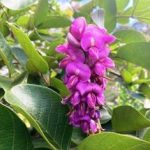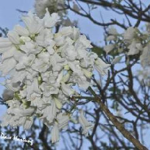Tree Life
October 2021
Hi Everyone,
Welcome to a new-look Tree Life! We must thank Mary Lovemore for the tremendous amount of work she has done over the past few years, not only keeping us all up to date with activities of our Society, but she has made tremendous efforts to capture all our Newsletters in a digital format. Amazing effort, and thank you Mary!!!
The Society intends resuming outings beginning this coming Saturday 2nd October with the normal 5th Street, Botanical Garden visit starting at 8.30am and finishing around 10 am. It will probably be hot, so bring a hat and something to drink and perhaps some sort of snack, especially if you are prone to fainting spells.
The Newsletter should have contained an article written for Kirkia by the original director, Hiram Wild on the establishment of the Herbarium and Botanical Garden at its present site. However we have quite a lot of content so that will be sent out later on its own. I hope to improve it a little, for historical reasons by adding some up to date photographs to compliment the original illustrations.

Moringa responding to managed, forced competition from sunhemp Photo Rob Jarvis
I know when Tom Muller used to take us on guided tours a couple of years back, it was fascinating getting an insight into just how it developed. Personally I learnt that if you plant rainforest trees, be sure to subject them to early competition, just as they would face in the natural forest so they develop a reasonably long straight bole before allowing branching some distance off the ground. Many of the trees in the rainforest section are falling apart now because they were planted widely apart but then branched too early! I know this comment by Tom had such an impact on me that I immediately adopted the practice of planting fast-growing sunhemp and dolichos beans around the edges of any tree planting holes where we now live. The results have been spectacular and I expect to write more about this Forest Garden concept in due course.
I hope my time as Editor of Tree Life will be rewarding and thank the Chairman, Tony Alegria and Mary for allowing me to take up this challenge! It should be fun!
Cheers Mafungi (Rob Jarvis)
Tree of the Month
Pod mahogany Afzelia quanzensis

Afzelia quanzensis tree Photo by Rob Jarvis
If ever there was a tree custom designed for a garden in Zimbabwe, the pod mahogany is a prime example. Deciduous, with a broad spreading crown, in winter the tree sheds all its leaves allowing the winter sun through to warm the coldest of gardens. Then as temperatures heat up through September and become fiercely baking during October the tree almost overnight bursts into fresh new bright green leaves. In the photo taken in early September you can just see the beginning of the new flush and now at the time of writing right at the end of September the tree is providing the ideal shade needed for the blazing summer sun. We are fortunate to have one planted perhaps 30 years ago in the front garden of the house we live in at ART Farm in Pomona and the positioning was brilliant, some 25 metres away from the house, almost due north and the welcoming shade is where we breakfast, have tea, take sundowners and have lunch and dinner parties.
Down at the office there is another specimen, this time planted to the southeast of the offices, much closer and on a lawn that gets frequently watered and it has burst into leaf a whole month earlier. Its positioning is pretty close to a water/observation tower some ten metres high and from the topmost deck we are able to peer down right into the pods and see the seeds lying cosily in their natural presentation cases. The bright red waxy aril contrasts beautifully with the jet black seed to which each is attached. Perhaps the greatest attribute of this tree is that youngsters are fascinated by these seeds and many a love for trees will have been engendered by kids finding the seeds, learning to rub the blunt end of the seed against a rough concrete or rock surface and then watching the wonder of germination take place with the cotyledons springing forth from the soil. Like magic.
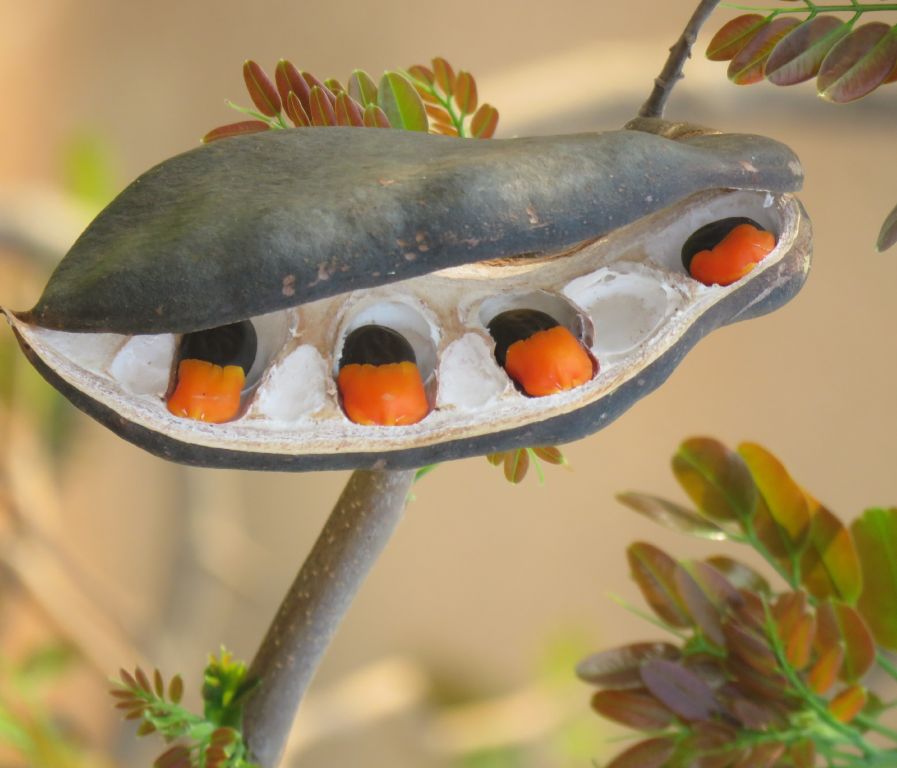
Afzelia quanzensis pod Photo by Rob Jarvis
The tree itself is renowned for having a wonderful timber, that takes polishing extremely well and makes the most fantastic furniture. We actually have a cube of rough-sawn wood that we purchased from a friend way back in the 1980’s and is destined one day to make a prized piece of furniture. Part of the wood my wife used to make a kitchen block for English relatives who were based here in Harare in the early 1990’s and when she last visited them in England nearly a decade ago, the kitchen block still has pride of place in their suburban home in Aldershot.
So if you do plant a tree, plant a custom-built one!
Rob Jarvis
Trees of the highveld

Trees of the highveld Photo by Rob Jarvis
Spring is a great time of year to wander through our rural areas and observe the features of the various trees we have in Zimbabwe. A couple of weeks ago in Musana Communal area, beyond Ngomakurira we chanced upon this grouping of three iconic trees. On the left is Parinari curatellifolia (Mobola plum) on the right is Uapaca kirkiana (Mazhanje or Mahobohobo) and in the centre background a Pterocarpus angolensis commonly known as Mukwa, Kiaat, or Bloodwood.
The Parinari is perhaps atypical for its species in this photograph in that you rarely see such a straight bole without low-hanging sheltering branches providing deep shade. The tree is rarely successfully grown as a garden subject probably because they just take too long to get established. They require well-watered soils and are common around the edges of wetlands where either standing alone or in copses they make stunning dark, shady features.
Uapaca is also not often grown deliberately, but natural forests of them are left by locals to produce their sweet tasting fruits in profusion at this time of year. Great loads of fruit are seen on roadsides around our major cities on the back of battered pick-ups during September and October as rural folk endeavour to make their fortunes assuaging the hunger of city slickers. Uapaca would make a great security screen around a high-tech office complex because it is absolutely impossible to walk silently on their dried leaves as they crunch explosively underfoot. There is a famous forest just at the foot of Domboshava mountain just north of Harare that legend tells us that the forest, if ever cut down, will spring up miraculously overnight! Wildlife absolutely depend upon these fruits for sustenance at this time of year, from rodents to elephant.

Inflorescence of Erythrina lysistemon Photo by Rob Jarvis
The Pterocarpus is much more likely to be grown as a garden subject because it readily strikes from truncheons and even large poles used in fencing cattle kraals and villages will root and start growing as living fence poles.
Not very far away from where I took the above photograph we were taking lunch in the shade of some Mountain brachystegia on top of a small rocky kopje and there just below us were the bright red inflorescence of Erythrina lysistemon the lucky bean or coral tree. Perhaps flowering a little later that usual this year but a welcome splash of colour in an otherwise drab countryside.
Four trees that almost all of us know and unfortunately under threat from rampant deforestation that is taking place all around our heavily populated areas.
Rob Jarvis
Eucalyptus by Tony Alegria
Myrtaceae – the myrtle family
Common names: cadaghi, cadaga and a few more.
Like most eucalyptus trees, this species is endemic to Australia but only occupies a small area in north eastern Queensland.
The Eucalyptus torelliana has been renamed and thus the old name is now a synonym, the new name is Corymbia torelliana . A corymb is a flower cluster whose lower stalks are proportionally longer so that the flowers form a flat or slightly convex head as in the diagram below from Wikipedia. The photo below of the Corymbia torelliana buds from the tree in the National Botanical Garden, looks more like a panicle.

Illustration of Corymb torelliana by Wikipedia and photo of inflorescences by Tony Alegria
Unlike many eucalypts seen around Harare, the Corymbia torellianas are not that tall and have the shape of what I would call a normal big tree. They are described as being medium-sized to tall, meaning they can be, by definition, 10 to 60 metres high in their natural habitat. Some of the trees I have seen in Harare are planted in a row as a hedge and so are not very tall and not very tree shaped either! You can see this at 90 Enterprise Road on the right hand side, just after the Glenara Avenue traffic lights if coming from the city. At this place, there are more than a dozen of these trees mostly planted as street trees. The tree shown below grows in the National Botanical Gardens next to the car park. It has many branches and some even grow downwards as they do in some Msasas. The photo of the branches was taken in a garden in Mandara, the tree was planted by the owner some 48 years ago.
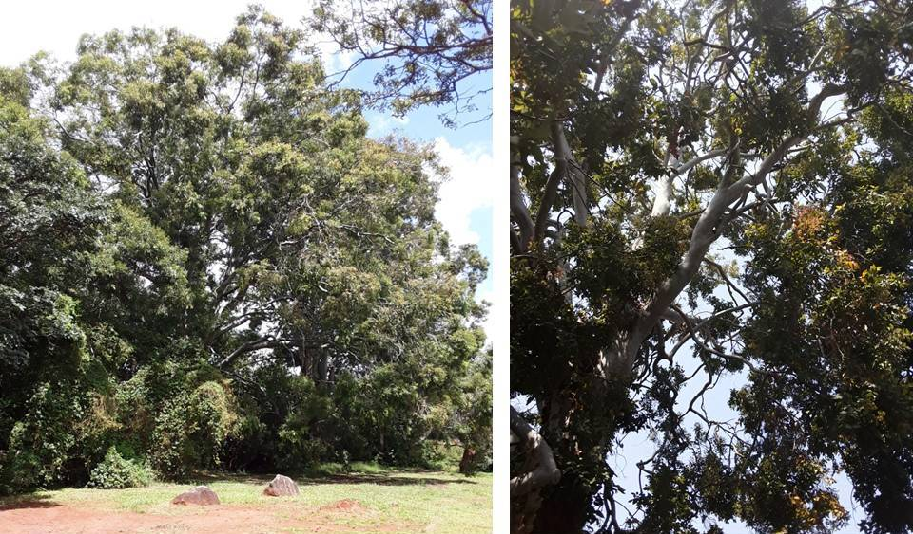
Corymbia torelliana trees and branching Photos by Tony Alegria
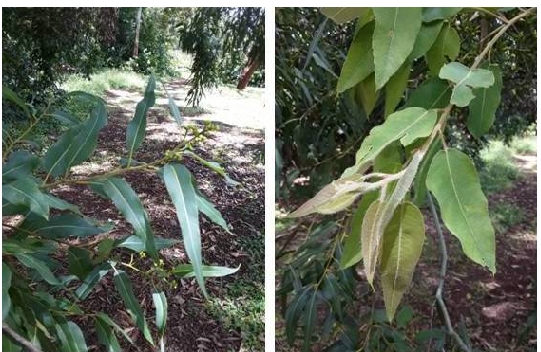
Adult (left) and juvenile (right) leaves of the Corymbia torelliana Photos by Tony Alegria
The strangest thing about these evergreen, rounded crowned trees are their leaves – aromatic as are most eucalypts. Many trees have juvenile leaves when they are young, but this tree has them all the time in addition to the adult leaves which look pretty much like most gum tree leaves – hairless, long and not very wide. Juvenile leaves are much wider and are hairy when young!
So, how do you recognize this tree, the most obvious feature is the light green to dark green bark. No other eucalypt appears to have green bark in Harare, so you can say that this is diagnostic!
Strangely enough this is not a feature in Australia where the bark is described as being grey to black. The bark is rough on the lower part of the trunk becoming smooth above. The branches are not all straight, some are pretty crooked. The photo below shows white flowers and up to seven buds with a short conical operculum. Unlike many gum trees that have cone-shaped fruit, these “gum nuts” (fruit) are barrel /urn-shaped to almost spherical measuring up to 15mm by 15mm.
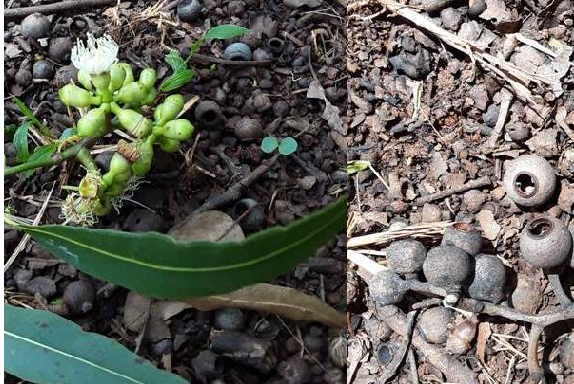
Corymbia torelliana flower and buds (left) and fallen fruit (right) Photos by Tony Alegria
Cypress grove in autumn at George L. Smith State Park, Georgia, USA
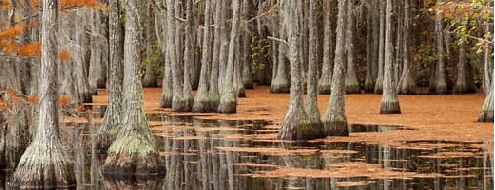
Photo of Cypress grove in autumn at George L. Smith State Park, Georgia, USA from https://bjonagera.art2day.net/
Roughly 80 miles from Savannah, this park in rural southern Georgia has a wide array of wildlife. Gopher tortoises, the Georgia state reptile, find a protected habitat here. Birds are especially plentiful too, with white ibis and great blue heron being avian residents. These wading birds frequent the Parrish Mill pond and its groves, including Spanish moss-draped tupedo trees, and the bald cypress seen in our image. Cypress trees can grow to 30 metres tall, and some of them grow pointy ‘knees,’ the purpose of which isn’t entirely clear. Scientists believe they may help stabilise the tree within its submerged landscape, or perhaps provide more oxygen.
Editor’s note: The above photo and short description was submitted for publication by our Chairman Tony Alegria. I am sure most of you have seen these swamp cypresses around and I know we tried to grow one, several attempts all totally unsuccessful, at the bottom of our empty dam at Rockyvale in Rolf Valley. There was a magnificent specimen not far away at Brookfield on Enterprise Road, but I think even that has since died. They probably really do have to be established in standing water to thrive.
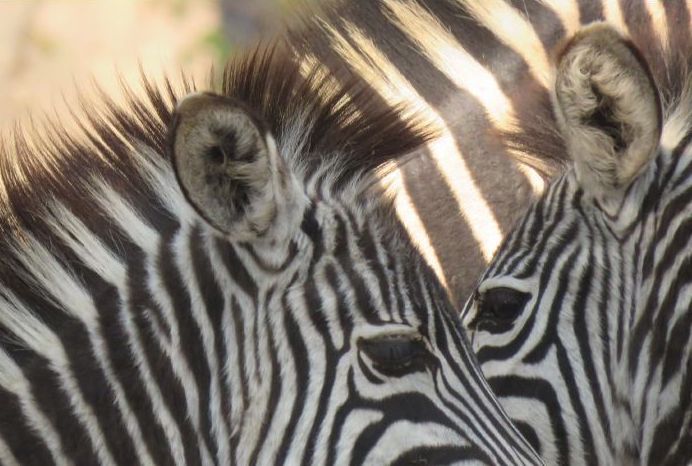
Zebras Photo by Rob Jarvis
As the Tree Society of Zimbabwe it is vital that we see eye to eye with the authorities on how to tackle the problems of rampant deforestation taking place all over Zimbabwe. A lot of this is driven by economic problems in particular the need for fuel to cook, to warm homes and heat water in urban and rural environments. Rural and urban electrification has helped but with the erratic rainy seasons and the degradation of infrastructure such as power lines, theft of oil from and even of whole transformers it has almost become a losing battle. In fact just this year we are seeing woodlands being cut down on a wholesale basis right across the country. There is the Forestry Commission, the Environmental Management Agency and the Zimbabwe Republic Police. These are institutions and parastatal organisations with clear responsibilities to manage and police the health and safety of the forests and trees of Zimbabwe.
In the last couple of years there has been a wellspring of well-meaning individuals and community-based organisations that have taken to tree planting and re-afforestation in a big way. These are excellent initiatives and many are targeting using local schools as a base for encouraging and looking after the tree-planting exercises undertaken. The City Councils are willing though often not capacitated to help and they probably quite rightly see water supply, housing, road maintenance, waste management and sewage infrastructure as more pressing priorities. Lately there has been some convergence in thinking on the importance of wetlands in the overall scheme of things. Thankfully because it was really quite scary to see developments taking place on land that had clearly been designated almost a century ago as dedicated green belts and perennial wetlands.
We can mitigate what has already been done by securing what remains, by encouraging the planting of trees and preservation of grass and wetlands wherever they still occur and individually and as communities by making sure that our own homes, gardens and communities trap the rain that does fall, allow it to soak into the ground through an above ground mulch of leaves and grass understorey and minimise the run-off of excess water down roads and storm drains. In fact there is no such thing as excess rain, every drop belongs on the soil where it lands and must soak in within metres of a roof, road or car park.
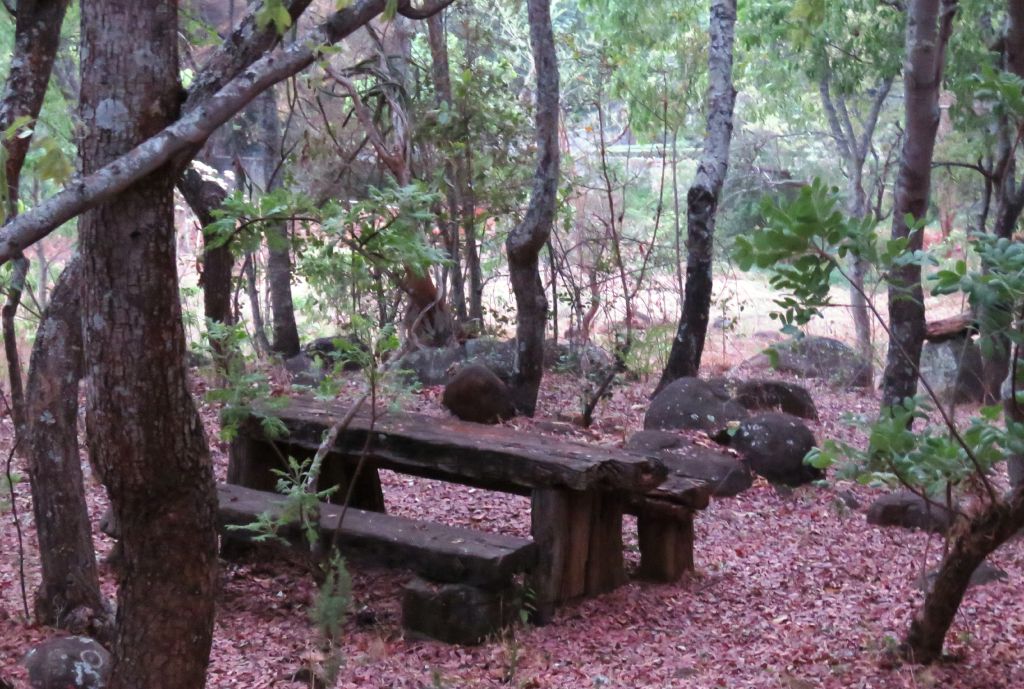
Natural mulches are by far the best way to trap the rain Photo Rob Jarvis
And of course collectively we must acknowledge that the green lawns and lush tropical garden landscapes really do not belong in the Zimbabwe of today. A borehole on your property, no matter how prolific it is, does not belong to you alone. Our major cities are literally on the verge of collapse because the water supplies are so precarious and until our combined efforts ensure that rainfall is captured where it falls and allowed to percolate down into the river systems and feed naturally into both natural underground storage and the man-made dams and weirs.
Natural mulches like in the photograph on the right are by far the best way to trap the rain.
Is yours working?
Rob Jarvis
National Botanical Gardens Report for 4th September 2021
by Tony Alegria
The easing of the lockdown after Covid phase three came just in time for us to have a tree walk at the National Botanical Garden in its usual slot – the first Saturday morning of the month. Fourteen of us enjoyed a walk about on a bright sunny day, present were the ladies : Ann Sinclair, Cassia Ryan, Dawn Siemers, Frances Morris, Marina Mason, Mary Lovemore, Meg Coates Palgrave and Teig Howson. The men were: Jan van Bel, Jim Dryburgh, Mark Hyde, Peter Morris, Ryan Truscott and myself.
As we hadn’t seen much of the gardens for quite a while and the fact that we are now in Spring, I decided that we should look at whatever was in flower. We didn’t do a very long walk, almost straight to the Herbarium and back again near the fence line to complete the circle.
The first tree we looked at was not in flower, it was the Tamarindus indica. Tamarind which was leafless in the upper parts but still losing its leaves in the lower branches. What was fascinating was that many of the leaflets that were exposed to the light had turned purple and the parts of the leaflets that were shielded from the sun by the other leaflets were still green!
After having a quick look at an Acacia nigrescens. Knobthorn, which had purple buds and off-white flowers in spikes, we went to look at a fig tree, Ficus bussei that was laden with figs, but no leaves. Figs of course have the flowers on the inside of what people call the fruit but are syconiums, the fruit is a tiny nutlet which gives the crunch in fig jam.
We then went to have a look at a bush/tree which Mark and I saw three weeks prior to this walk. That particular walk was a stretch-your-legs walk by Mark and myself and not a Tree Society outing! Mark did a write up on this walk and did mention the Ritchiea albersii with its palmate leaves and inflorescences that resemble the woolly caper-bush flowers – not surprising as they both belong to the same family! Why we have never seen this bush before is a mystery as not only did we see the flowers three weeks ago, but right now there are even more flowers and quite a lot of buds. This tree which is very rare was the highlight of the day for our guru – Meg Coates Palgrave. Now that we know where it is, we can keep an eye on it!
Recently, we had an email from Mary Toet in which she asked if the Fernandoa abbreviata is infertile as she has never seen any fruit on them. I also have never seen fruit, so if anyone has seen some, kindly let us know where so we can go and have a look. With this in mind we then headed off to the other side of the Herbarium to look for fruit on the many Fernandoa abbreviata there, of course we failed – no fruit, no leaves but lots of flowers. Incidentally, these trees have been mislabeled as Fernandoa magnifica.
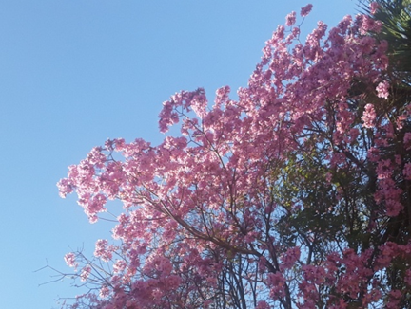
Tabebuia heterophylla in flower Photo by Tony Alegria
By now it was time to leave, so on the way back we looked at the spectacular pink flowering Tabebuia heterophylla next to the herbarium. For the first time we noticed that some of the flowers had yellow throats and really looked pretty, not far off, the other pink Tabebuia, Tabebuia heptaphylla didn’t look so great with its more frilly but paler pink flowers.
Other trees seen in flower but not mentioned above:
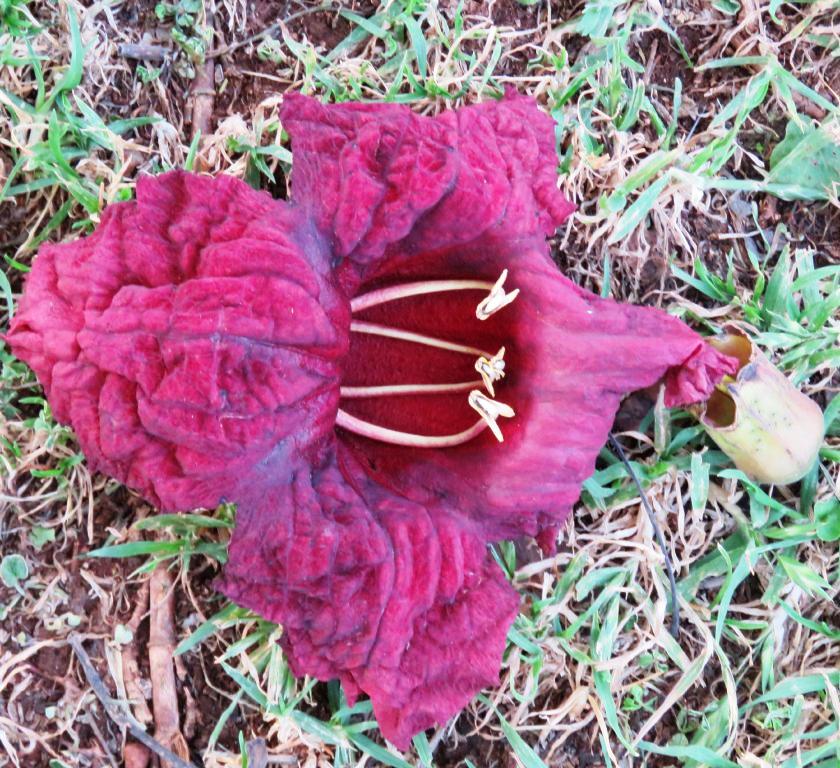
Kigelia africana flower Photo by Rob Jarvis
Kigelia africana with deep purple/maroon flowers (see right)
Albizia anthelmintica with its off-white shaving-brush flowers
Newtonia buchananii with spikes of off-white flowers
Melia azedarach with pale purple petals and a dark purple staminal tube
Erythrina abyssinica and E. lysistemon with their red flowers
Tabebuia chrysotricha with bright yellow flowers
Petrea volubilis with purple flowers
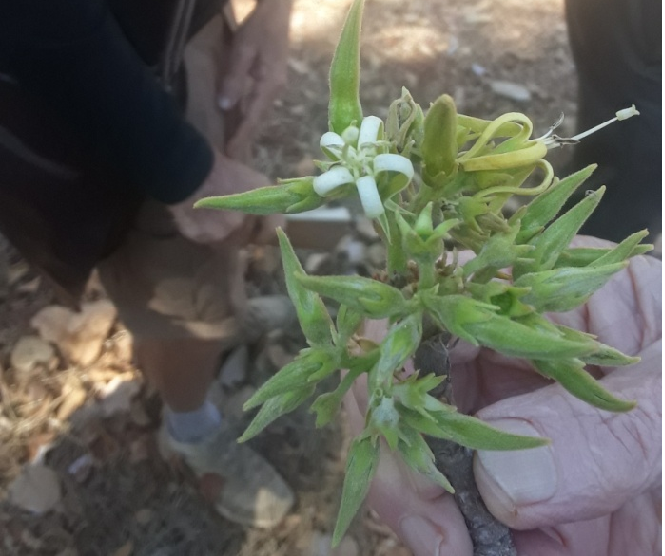
Vangueriopsis lanciflora flower and buds Photo by Tony Alegria
Combretum paniculatum with red flowers
Vangueriopsis lanciflora which were leafless but had many, many buds and a few white flowers.
Editor’s note
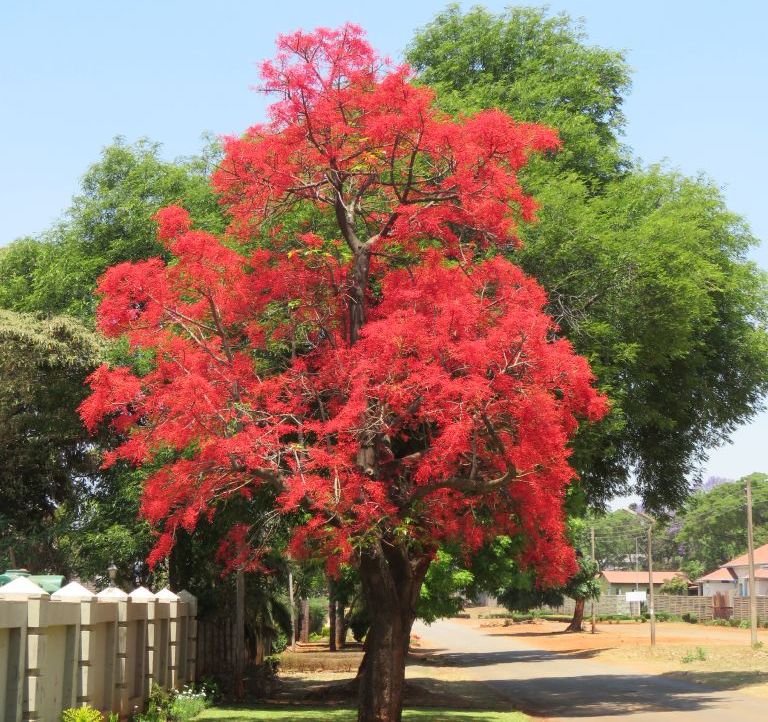
Brachychiton acerifolius is out in its full glory Photo by Rob Jarvis
At this time of year the Australian flame tree Brachychiton acerifolius is out in its full glory. This particular specimen was photographed just below Eastlea School in Upper Hillside, Harare. There is something special about trees that signal the onset of spring with a blaze of colour from their flowers only and virtually no leaves. Jacarandas, Tabebuias and many others follow this pattern.
Mukuvisi Woodlands on 28 August 2021
by Jan Van Bel
We were meeting at Mukuvisi Woodlands, the perfect place for beginners to familiarise themselves with indigenous trees. Still under corona regulations, we were only 3. Tony, our chairman; Mark, our botanical dictionary and me in need of a refreshing course with trees that have labels on them.
We first walked around the parking area where we are familiar with the trees. A look at the Acacia schweinfurthii, River climbing acacia, to get a better grip on the differentiation with the other look alike, the Acacia ataxacantha, Flame acacia, which can be seen inside the park. Observations were made and we came to a consensus that the Flame acacia usually behaves more like a tree; its petiolar gland further away from the attachment point; the pulvinus less obvious.
Walking to the site of the paddocks, past the Acacia galpinii, Monkey thorn and behind the Ficus burkei, we came to the huge Carrot tree, Steganotaenia araliacea which was in full bloom, flaunting an abundance of flowers in compound umbels. On the side of the paddock we looked at Vachellia gerrardii, Grey-haired acacia with their spines on inflated cushions, and at the Senegalia goetzei, Purple pod acacia, the more common subspecies with slightly larger leaves. Further on a Schinus terebinthifolius, Brazilian pepper tree, needed some closer examination, so Mark collected a leaf. There were very few flowers to been seen yet. Freylinia had also not yet woken up. Passing under the huge Ficus sycomorus, Mark mentioned that this one was the subspecies gnaphalocarpa which is usually a smaller tree (not obvious here) with slightly larger fruits up to 4,5 cm. We were now inside the fenced area. Feretia auruginescens had some old coppery leaves remaining and was starting to roll out new leaf buds. Bright yellow colour from Senna singueana, Winter senna, brought some welcome contrast in this otherwise grey and sleepy woodland. Close by we looked at Senegalia ataxacantha, Flame acacia, and compared it with the sample of A. schweinfurthii, we had collected. This one looked more like a tree. Although dry and lifeless most of the trees were, it is still interesting to see how typical and recognisable many are, even in their dishabille or leafless state.
Entering the wild area through the small gate, past the viewing platform, we passed under the huge eucalyptuses and had a look at several foreign Ash trees, Fraxinus. We followed the path which on Sundays is busy with walkers and cycling children and went in the direction of the anthills. We found a small Mystroxylon, Kooboo-berry. Dovyalis caffra, Kei-apple and Flacourtia indica, governors plum, were well represented here. These two species from the same family were sometimes difficult to differentiate.
At the foot of the anthill Ehretia obtusifolia, Stamperwood, was identified. This association with anthills seems typical, as I remember only seeing it in such spots. On top of the hill was a big Schotia brachypetala, Weeping boer-bean, and another high tree that couldn’t be identified although it had some leaves remaining but they were too high to have a closer look.
Several weeds were identified by Mark. We went back along the river at the side of the park and saw what was probably a Sesbania sesban, River bean, and a whole spot of those agave-like plants we encounter regularly: Furcraea foetida, Mauritian hemp, its name referring to the stench it produces when chopped. It has leaves nearly 2 m long. Going back we had a drink under the trees and decided that it was time to have some proper tree walks after that long lockdown.
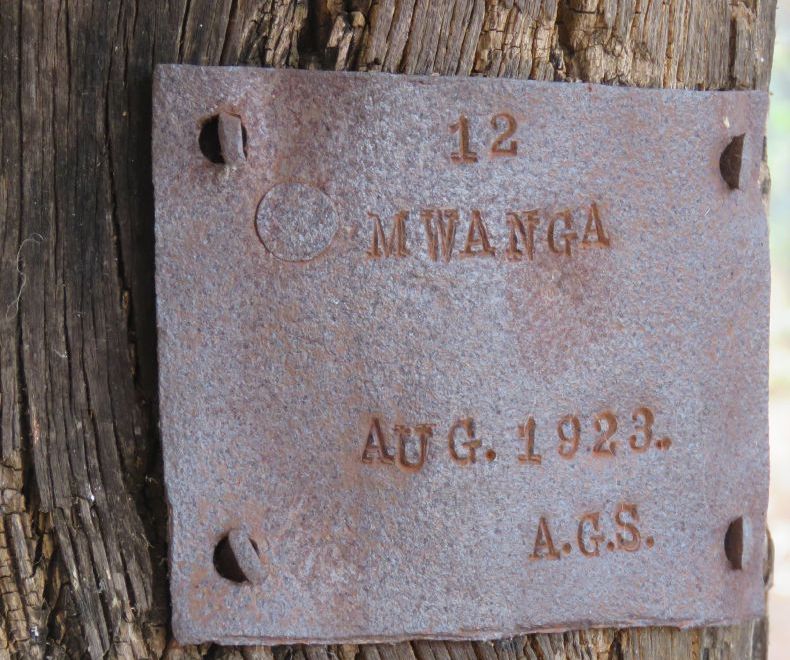
A. G. Staunton put a label on log he had cut down in 1923
Editor’s note History is a wonderful thing and when it is recorded somehow it can be very poignant. Amazing that way back in 1923, almost 100 years ago, one A. G. Staunton put this metal plaque on a Muwanga tree that he cut down to use as a roof beam on a cattle dip he constructed on his pioneering commercial farm at Enterprise. Later during the turbulent land reform years between 2000 and 2009 this beam was recovered and used as a support pole on the verandah of a lodge then being constructed at the nearby Bally Vaughan/Muwanga Lodge complex on the other side of the Shamva road. How he hammered those nails in is anyone’s guess because Muwanga is renowned as one of the most durable timbers of them all. Virtually indestructible. When recording our activities we shall try to get photographs of trees mentioned so that the picture becomes part of the record of what we have done and seen.
CHAIRMAN TONY ALEGRIA


